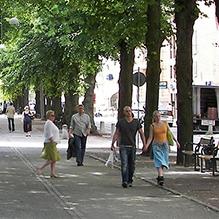Launch of tool to encourage consumers to fly less by highlighting climate impact
As the climate issue heats up, consumers are becoming more conscious of their impact on the environment. ‘Flygskam’, or ‘flight shame’ is a growing trend that reflects the increasing awareness of flying’s harm to the environment. Now, the Climate friendly vacationing network including researchers from Chalmers present a tool that allows consumers to evaluate the outcome of their different travel options.
The new website – travelandclimate.org – gives an instant and simple calculation of the emissions from different modes of travel for a given journey.
For example, for 2 people travelling from London to Barcelona, the tool gives a calculation of 130kg of carbon dioxide equivalent emitted for a train or bus journey, 244kg by private car, and 371kg by plane.
The Swedish version of the tool has already existed for around a year, receiving coverage in most of the major Swedish media outlets, and has had over 50,000 unique visitors since it began. Alongside the launch of the English version, the Swedish version klimatsmartsemester.se has been revamped with more information and a new design.

The website is based on research by Jörgen Larsson and his group from Chalmers University of Technology, looking at the impact of Swedish flying habits on the climate.
“Our studies have shown that Swedish flying results in emissions of about a tonne of carbon dioxide equivalents per citizen. This is around five times higher than the global average, and roughly the same as Sweden’s total emissions from car usage,” says Jörgen Larsson.
Their analysis of historical data from 1990 to 2017 has also shown the dramatic increase in flying overall. International flights from Sweden have doubled, from 0.5 trips per person in 1990 to 1.0 trips per person in 2017. The average distance of these trips is about 2700 km one-way – roughly the distance from Stockholm to Madrid.
Continued rising emissions from aviation threaten the target of the Paris Agreement, of keeping global warming well below two degrees. Jörgen Larsson hopes the new tool will help to further spread knowledge of flying’s damaging effects and contribute to fewer flights.
“Reaching the two-degree target will require changes in our lifestyle. Maybe if everyone adopted a vegan diet instead, flight emissions would not have to decrease so much,” he explains. “But that would also be a large intervention in our lifestyle.”
Much is made of the technical developments of aircraft and engines, with better aerodynamics and more efficient operations. It is true that these have had an effect, and emissions per passenger kilometre have fallen by roughly 2% each year in the period. “The problem is that air travel has simultaneously risen by over 3%,” says Jörgen Larsson. Emissions in total have therefore increased.
More information about the data behind the tool
The new website offers consumers a chance to easily and quickly calculate the impact of different transport methods for their travel plans, offering a side by side comparison.
Watch a video trailer for the new website here.
“Previous methods of measurement had only accounted for the fuel tanked in each country. This meant that a flight from Stockholm to New York, via Amsterdam for example, only the fuel loaded in Stockholm would be measured,” explains Jörgen Larsson. The researchers’ new methods have been developed to account for the whole trip.
All the calculations and figures for the tool are available in a methodological report on the site. It is currently only available in Swedish, but an English version will be published in June.
Read the study “Measuring greenhouse gas emissions from international air travel of a country’s residents methodological development and application for Sweden” in the journal Environmental Impact Assessment Review. Read the study “International and national climate policies for aviation: a review” in the journal Climate Policy.
Read the study “Local governance of greenhouse gas emissions from air travel” in the Journal of Environmental Policy & Planning”
Read the report “Climate footprint from Swedish residents’ air travel” on the Chalmers research.
The following organisations have supported the development of the platform: Region Västra Götaland via Klimat 2030, the Centre for Tourism at the University of Gothenburg, Chalmers University of Technology, West Sweden Tourism Board, The City of Gothenburg, Göteborg & Co, Mistra Urban Futures and Mistra Sustainable Consumption. More about the funding, organisations and the researchers behind the project can be found here.
More info
Criticism of such a powerful industry as aviation has not been met without resistance. Last year, Jörgen Larsson found himself the centre of a media storm, with the Swedish Air Transport Society accusing him and his colleagues of conducting unscientific research. The ensuing debate resulted in the Presidents of both Chalmers University of Technology and KTH publishing an article in a Swedish national newspaper condemning the hypocrisy and incorrect information being spread from the Swedish aviation industry. Eventually, the researchers met with representatives from the Swedish Air Transport Society to clear the air, and a positive working relationship developed. Now, the researchers have started a collaboration with Swedavia, the national Swedish airport operator, giving them direct access to large amounts of data for use in further research.
For more information, contact:
Jörgen Larsson
Assistant professor, Department of Space, Earth and Environment, Physical Resource Theory
jorgen.larsson@chalmers.se
+46 708 833370







